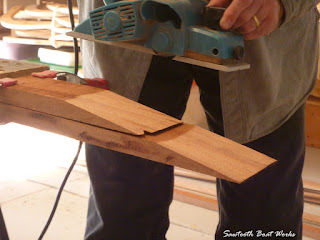After spending many, many hours sanding the epoxy on the interior and exterior of the hull, we are ready to start building again. The gunwales are the next step. The scuppered type that we install are more work than most other types, but we feel their good looks are worth the extra effort. The scuppers give the traditional look that canoes had when ribs extended between the inwale and hull. The scuppers also allow all of the water to be drained from the canoe when tipping it on its side.
We needed lumber about 16.5 feet long for the gunwales so we scarfed an extra section on to the end of the piece of African Mahogany that we chose in order to get it to the necessary length. An 8:1 scarf was used.
The scupper pieces are cut to length with a drill bit to give then a radius on each end. About 50 of them are used.
The scuppers were then epoxied in place on the sanded hull.
The breast hooks were then installed at each end.
The inwales came next...
...followed by the outwales. The outwales are different from the inwales in that the last three feet of each end has been tapered to a narrower depth. This gives the ends of the canoe a much finer look which really improves its appearance.
Some creative clamping is required in order to coax the gunwale into meeting the rise at the end.
All of the pieces come together to form a strong, rigid hull.














